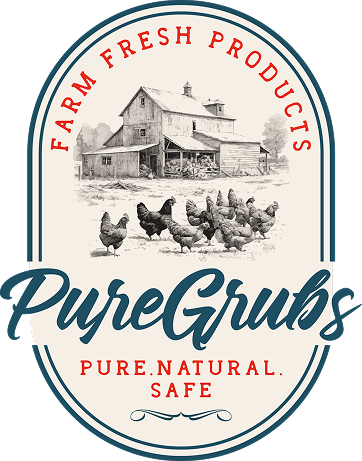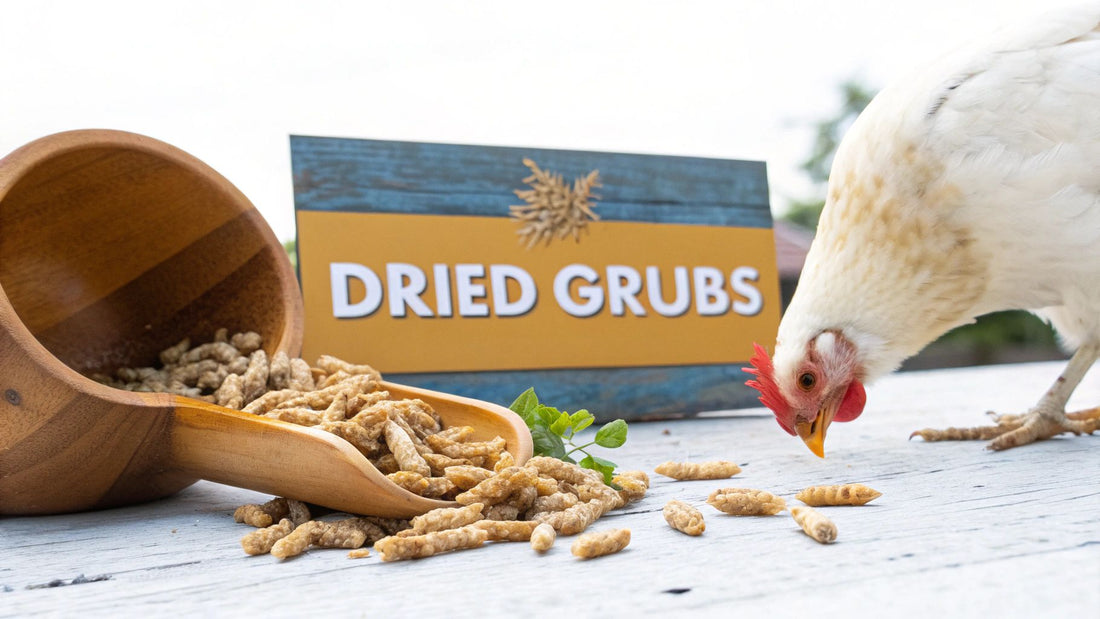
Ultimate Guide to Dried Grubs for Chickens: Boost Your Flock’s Health
Share
If you've ever kept chickens, you know they're basically tiny dinosaurs, always scratching and pecking for a tasty bug. Dried grubs tap right into that instinct. They're a super concentrated, protein-rich treat, usually made from Black Soldier Fly Larvae (BSFL), that gives your flock a serious nutritional boost. Think of it as the easiest way to improve their health, leading to better eggshells and beautiful, glossy feathers.
Why Chickens Go Crazy for Dried Grubs
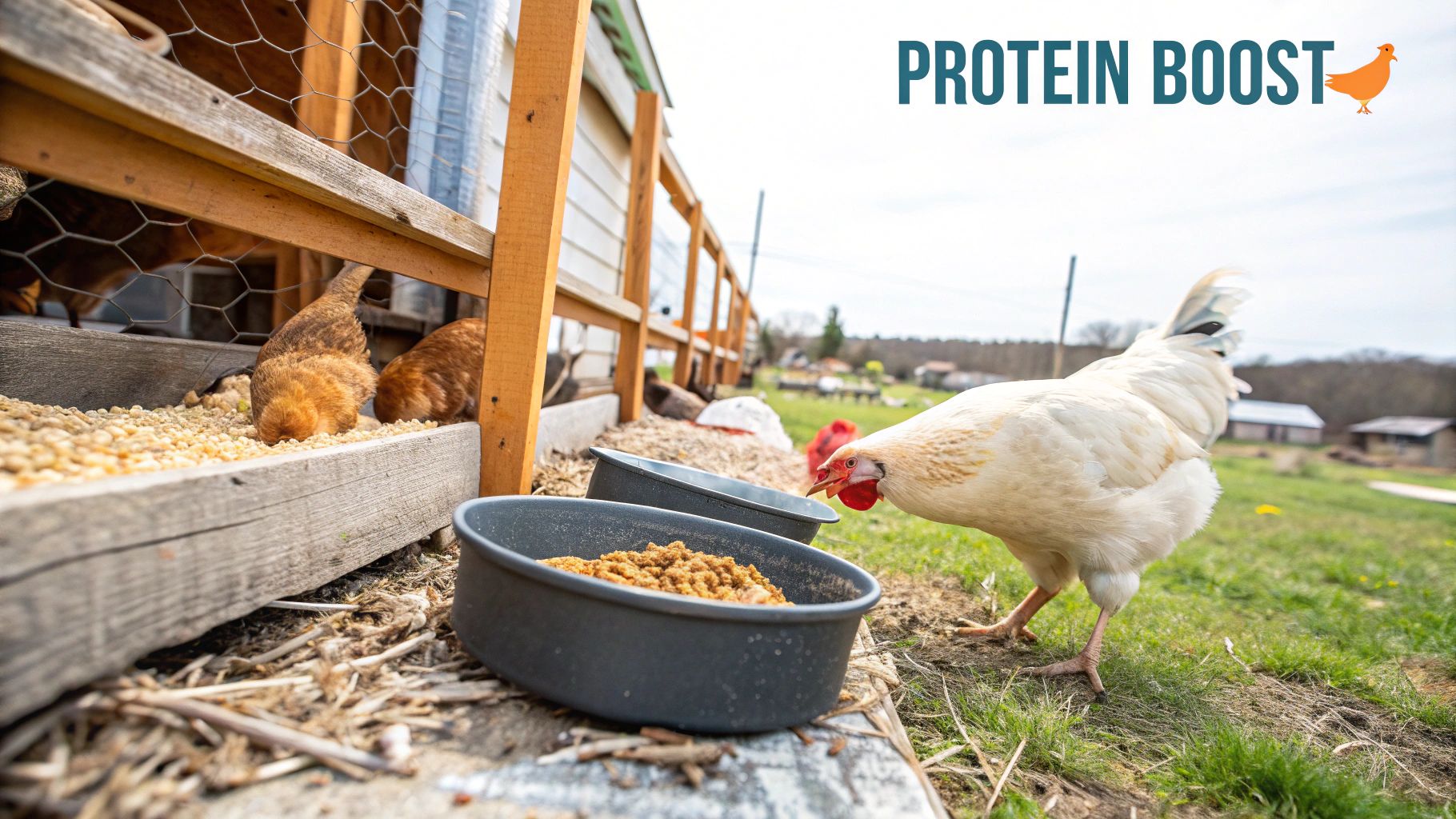
Toss a handful of dried grubs into the coop and just watch. Chaos. But it's happy chaos! That feathered frenzy you see isn't just about getting a snack—it's pure instinct. Chickens are born foragers, hardwired to hunt for insects, worms, and anything that wiggles.
Dried grubs are basically the greatest hits of their natural diet, all in one convenient, crunchy package. It’s not just a random craving; it's like they have a built-in nutritional radar that tells them, "Hey, this stuff is the real deal." You're not just giving them a treat; you're giving them a concentrated piece of the wild.
A Natural Powerhouse of Nutrition
These little grubs are far more than just empty calories. They're a genuine superfood for poultry, loaded with the good stuff: high-quality protein, essential calcium, and healthy fats. It's less like candy and more like a high-performance supplement that helps your entire flock thrive.
When you start adding them to your feeding routine, you'll see some real, tangible benefits:
- Stronger Feathers: Protein is the key building block for feathers, and the high concentration in grubs helps chickens grow a thick, healthy coat. This is a game-changer during their annual molt.
- Durable Eggshells: Grubs are a fantastic source of calcium, which is crucial for laying hens. More calcium means stronger, thicker eggshells and fewer frustrating cracks.
- Enhanced Vitality: The potent mix of healthy fats for energy and protein for muscle keeps your flock feeling spunky, active, and resilient.
Fueling a Growing Demand
It’s not just backyard chicken keepers catching on. There’s a huge global shift toward more sustainable and nutrient-dense animal feed. The poultry feed market was already valued at a staggering US$175.9 billion back in 2018 and is on track to hit nearly US$238.9 billion by 2025.
That explosive growth is driven by our own demand for high-quality eggs and poultry. For years, the industry relied on soybean and fishmeal, but their rising costs and environmental impact have sent everyone searching for better alternatives. Insect protein, especially from dried grubs, is stepping up as a fantastic solution—it's packed with nutrients and much friendlier to the planet. For a deeper dive into these trends, you can find great insights on the poultry feed market at Grand View Research.
Once you connect the dots between a chicken's natural instincts and the incredible nutrition packed into dried grubs, it's easy to see why they’ve become a must-have for anyone serious about raising a happy, healthy flock.
The Nutritional Power of Dried Grubs
At first glance, a handful of dried grubs might just look like a simple, crunchy treat for your chickens. But don't let their appearance fool you. Think of their daily feed as a well-balanced meal—it covers all the basics. Dried grubs, on the other hand, are like a high-octane protein shake, supercharged with the exact nutrients your flock needs to truly thrive.
This isn't just about giving them something tasty to peck at. The nutritional profile of dried grubs, especially Black Soldier Fly Larvae (BSFL), is what makes them a game-changer. They deliver concentrated energy and the raw materials chickens use to build strong bodies, grow healthy feathers, and lay fantastic eggs.
Decoding the Protein Punch
The nutrient that gets all the attention in dried grubs is protein, and for good reason. High-quality grubs pack a serious punch, often containing 40% or more protein by weight. That's a massive step up from standard feed or other common snacks.
So, what does all that protein actually do for your flock? It all comes down to amino acids, the fundamental building blocks of life. For chickens, this translates into real, visible benefits you'll notice around the coop.
- Muscle Development: Active, happy chickens need strong muscles to scratch, forage, and explore. Protein provides the fuel for that vigorous, classic "chicken" behavior.
- Feather Production: Feathers are nearly 90% protein. When your flock goes through their annual molt, their protein needs go through the roof. A protein-rich supplement like dried grubs helps them get through this stressful period faster, resulting in a beautiful, glossy new coat.
- Egg Formation: The egg white, or albumen, is almost pure protein. Supplying your hens with a consistent source of quality protein helps them lay strong, well-formed eggs day after day.
This infographic breaks down the macronutrients in dried grubs, showing you exactly what you're giving your flock.
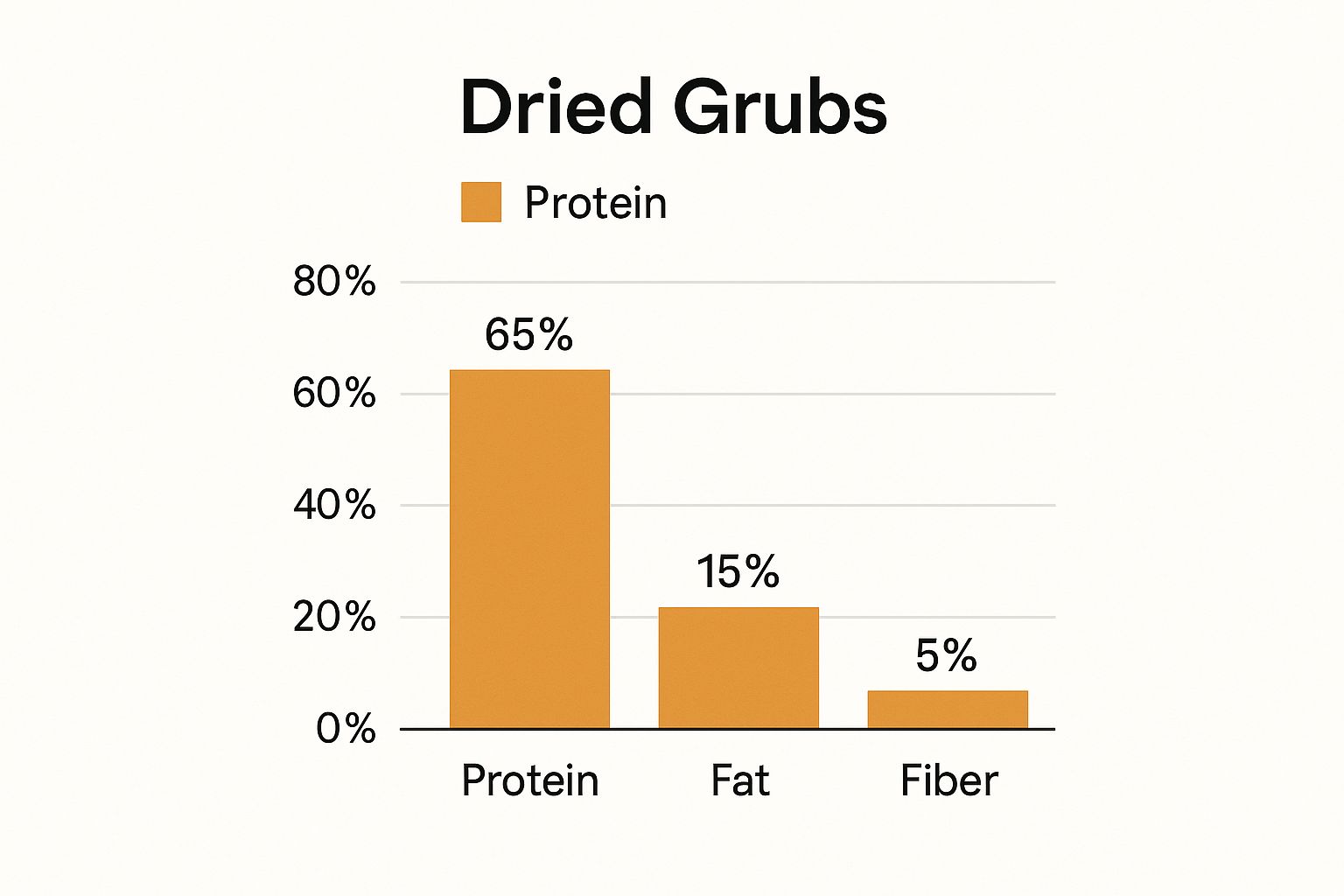
As you can see, protein is the clear winner here, making these grubs an incredibly efficient way to boost your chickens' diet.
Calcium: The Eggshell Architect
Protein is fantastic, but calcium is where dried grubs really pull away from the competition. It's their secret weapon.
Imagine you're building a brick wall. The bricks are essential, but without strong mortar, the whole thing will be weak and crumbly. For a laying hen, calcium is the mortar for her eggshells.
A hen’s body mobilizes a massive amount of calcium to form a single eggshell. If her diet is deficient, she will pull calcium directly from her own bones, weakening her skeletal structure over time.
Dried grubs offer a highly bioavailable source of calcium, meaning a chicken's body can absorb and use it with incredible efficiency. This boost leads directly to thicker, more durable eggshells. You'll find yourself dealing with far fewer cracked or broken eggs in the nesting box. For those wanting to ensure top quality, premium options like these USA-grown Black Soldier Fly Larvae have been tested for both quality and safety.
To put the nutritional superiority of dried grubs into perspective, let's see how they stack up against other common treats you might be giving your flock.
Nutritional Comparison of Common Chicken Treats
| Nutrient | Dried Grubs (BSFL) | Dried Mealworms | Cracked Corn / Scratch Grains |
|---|---|---|---|
| Protein | ~40-45% | ~50% | ~8% |
| Fat | ~30% | ~25% | ~4% |
| Calcium | ~2-5% | ~0.05% | ~0.02% |
| Calcium-to-Phosphorus Ratio | ~2:1 (Ideal) | ~1:7 (Poor) | ~1:10 (Poor) |
This table makes it crystal clear. While mealworms have a slight edge in protein, dried grubs (BSFL) offer a much more balanced profile with an ideal calcium-to-phosphorus ratio, which is critical for eggshell strength and bone health. Scratch grains, while a fun treat, are mostly carbohydrates and lack significant nutritional value.
Healthy Fats and Essential Nutrients
While protein and calcium grab the headlines, the story doesn't end there. Dried grubs also contain a healthy dose of fat, which is a crucial energy source. This is especially important during the cold winter months when your birds need to burn extra calories just to stay warm.
On top of that, grubs provide other key nutrients like phosphorus, which works hand-in-hand with calcium to build strong bones, and a whole host of amino acids that support overall health. This complete package makes dried grubs a uniquely powerful addition to your feeding routine. They don't just fill your chickens up—they build them up from the inside out.
How Grubs Improve Flock Health and Egg Quality
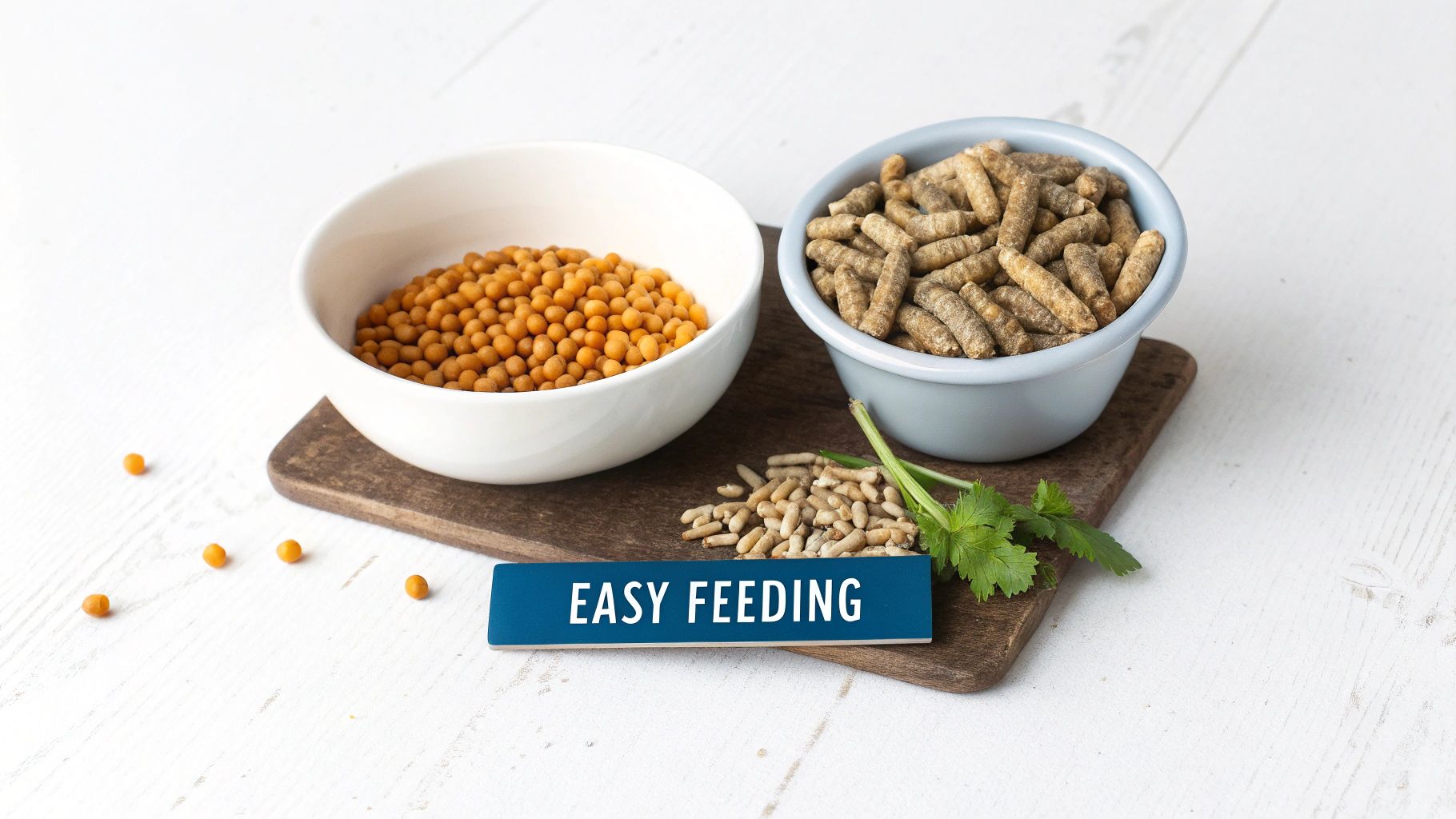
It’s one thing to read about the impressive nutritional stats of dried grubs for chickens, but it’s another thing entirely to see those benefits firsthand in your own coop. The high-quality protein, calcium, and healthy fats packed into these little grubs are direct inputs that lead to visible results in your flock's health and the eggs they lay.
Think of a chicken's body as a little factory, working around the clock to produce strong feathers and perfect eggs. Just like any factory, it needs top-notch raw materials to create a quality product. Dried grubs are that premium supply, delivering a concentrated shot of the exact nutrients that fuel the entire production line.
Fueling a Flawless Molt
Every year, chickens go through molting—a natural but incredibly demanding process of shedding old feathers and growing a new set. This is a massive project for their bodies. Feathers are made of nearly 90% protein, so a chicken’s nutritional needs go through the roof during this time.
This is where the protein punch from dried grubs really shines. Giving your flock a protein-rich supplement provides the essential building blocks they desperately need to regrow feathers quickly and efficiently.
Instead of a long, stressful molt that leaves your birds looking scraggly and vulnerable, a boost from grubs helps them:
- Bounce Back Faster: They can regrow feathers more quickly, which means less time spent in a vulnerable, unfeathered state.
- Grow Better Feathers: The new plumage that comes in is often stronger, shinier, and provides much better insulation for the cold months ahead.
- Lower Their Stress: A fast, efficient molt is far less taxing on a chicken’s system, helping them get back to their quirky, energetic selves sooner.
You're not just helping them look better; you're fundamentally supporting their health during one of the toughest times of the year.
Building Better Eggshells from the Inside Out
Cracked eggs are one of the most frustrating parts of keeping chickens. You put in all the work, only to find a fragile, broken shell in the nesting box. More often than not, the culprit isn’t a clumsy hen but a dietary issue—usually a lack of calcium.
Imagine finding consistently strong, smooth shells in your egg basket every single day. That's the direct result of giving your hens the right building materials. Dried grubs, with their naturally high calcium content, are one of the best ways to make that happen.
A laying hen’s body performs a small miracle every day, pulling enough calcium from her diet to form a hard, protective shell. When you offer dried grubs, you’re providing a highly absorbable form of calcium that goes directly into eggshell production. This leads to thicker, more durable shells that are far less likely to crack. It’s a simple change for a much more rewarding outcome.
The Global Shift Towards Superior Poultry Nutrition
This focus on high-impact nutrition isn't just a backyard trend; it's a global movement. Research consistently shows that poultry fed insect protein exhibit fantastic health outcomes. In fact, studies show that chickens on these diets have growth rates and overall health that are just as good, if not better, than those on conventional feeds.
Insect-based protein is so effective that it can make up 5-15% of commercial poultry feed formulations in different parts of the world. Countries across Asia and Europe are already leading the way in producing insect protein for animal feed, recognizing its power to support both animal welfare and food security. If you'd like to dive deeper, you can learn more about the global animal feed market on mordorintelligence.com.
When you add dried grubs to your flock's diet, you're using a strategy backed by modern science to give your chickens some of the best nutrition available.
Alright, let's get into the nitty-gritty of how you should actually be feeding these tasty little grubs to your flock. It's not rocket science, but a little know-how goes a long way in making sure you’re helping, not hurting, their overall diet.
The absolute golden rule, the one thing you need to remember, is the 10% treat rule. Think of it this way: your chickens' complete layer feed is their balanced, wholesome dinner. Everything else—grubs, scratch grains, kitchen scraps—is dessert. And just like with us, too much dessert can throw things out of whack.
So, keep all treats, including these protein-packed grubs, to no more than 10% of their total daily food. A good starting point is about one to two tablespoons of dried grubs per chicken, per day. It's best to offer these after they've already had a good go at their main feed, so they don't fill up on the good stuff and skip their essential vitamins and minerals.
Fun Ways to Serve Up Grubs
You can just toss them on the ground, but where's the fun in that? Mixing it up keeps your flock entertained and can even help you build a stronger bond with them.
-
Scatter Them Around: My favorite method is simply tossing a handful of grubs across their run or pasture. It kicks their natural foraging instincts into high gear. Suddenly, they're not just eating; they're on a treasure hunt, scratching and pecking just like they were meant to. It’s a great boredom buster!
-
Mix 'Em In: Got a picky eater? We all have one. Mixing the dried grubs directly into their regular feed can be a lifesaver. It adds a little something extra that encourages even the fussiest hen to clean her plate, ensuring she gets all the nutrients from her layer feed.
-
Feed by Hand: There is no better way to earn a chicken's trust than to offer their favorite snack right from your hand. It's a slow and steady process, but over time, they’ll start to see you as the bringer of delicious things. Before you know it, you'll have them literally eating out of the palm of your hand.
When to Give Them an Extra Boost
Dried grubs are a fantastic treat any day of the year, but they're especially powerful during times when your flock is under a bit of stress. Think of it as giving them a targeted nutritional boost right when they need it most.
When chickens are going through a tough time—like molting or shivering through a cold snap—their bodies are working overtime. Giving them an easy-to-digest source of extra protein and fat can make a huge difference in how well they bounce back.
Here are the two most important times to be generous with the grubs:
-
The Big Annual Molt: Molting is no walk in the park. Chickens lose their old, ragged feathers and have to grow an entirely new set. Feathers are made of almost 90% protein, so you can imagine the insane amount of protein their bodies need during this time. A daily grub supplement gives them the building blocks to regrow a beautiful, healthy coat of feathers much faster.
-
Cold Winter Days: Keeping warm takes a ton of energy. When the temperature plummets, chickens burn through calories just to maintain their body heat. The healthy fats in dried grubs are a concentrated energy source. A handful before they head into the coop for the night is like a warm, high-energy meal that helps them stay toasty until morning.
By using dried grubs strategically, you’re doing more than just giving a treat. You’re providing smart, timely support that helps keep your flock healthy, happy, and thriving all year long.
Choosing and Storing the Best Dried Grubs
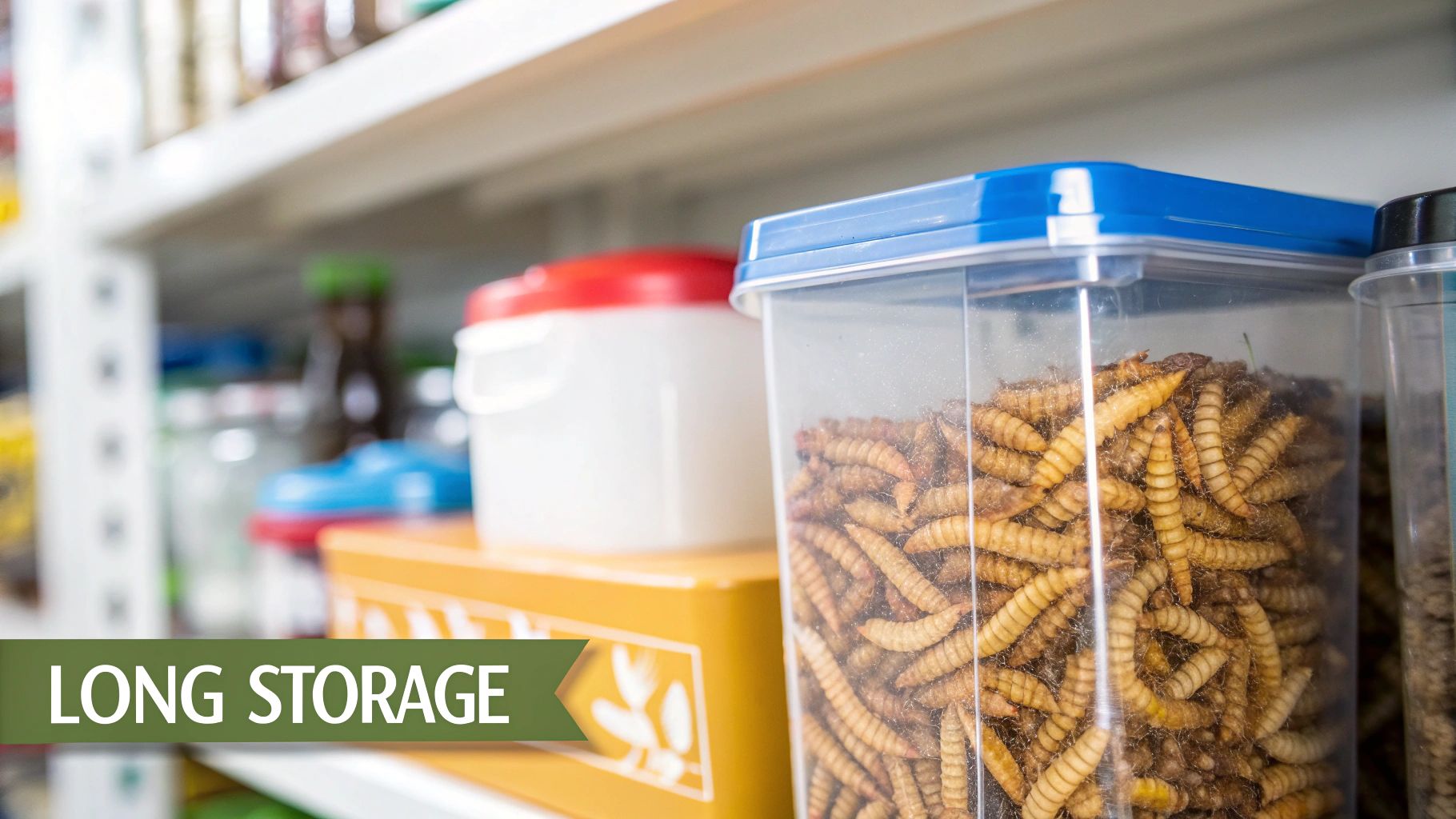
Walking down the feed aisle, you'll see a dozen brands of dried grubs for chickens, and they all seem to promise the same thing. But here’s the truth: not all grubs are created equal. Knowing what to look for is the key to bringing home a safe, high-quality treat for your flock instead of a bag of mystery bugs.
Think of it like buying your own food. You want to know where it comes from and what’s in it, right? The same logic applies to your chickens' food. The quality of a dried grub starts long before it hits the shelf—it begins with what the larvae were fed and the environment they were raised in.
What to Look For on the Label
When you're comparing bags, a few key details on the label will tell you everything you need to know about the product's quality and safety.
- Country of Origin: I always recommend looking for grubs grown and processed right here in the USA. This isn’t just about patriotism; it’s about accountability. Products from the US have to meet much stricter safety and quality standards.
- Safety Testing: A reputable brand will openly state that they test their grubs for contaminants like lead, mercury, and other heavy metals. This is non-negotiable, especially for laying hens, since you’ll be eating their eggs.
- Sustainable Sourcing: The best, most eco-friendly grubs are raised on pre-consumer food waste—things like leftover grains from breweries or unsold produce. This is an amazing process that diverts waste from landfills and turns it into a protein-packed superfood for our birds.
Giving insects to chickens is nothing new; it’s actually a practice with deep historical roots. For centuries, farmers in Africa and Asia have relied on chickens foraging for insects and often supplemented their diets with dried mopane worms or black soldier fly larvae. It was, and still is, a brilliant way to boost protein, which can be as high as 40-70% in dried grubs.
Proper Storage to Maximize Freshness
So, you've brought home a great bag of grubs. Don't stop there! How you store them is just as important as the quality you buy. Good storage keeps them fresh, protects their nutritional value, and keeps unwanted critters out.
First things first: get them out of that flimsy bag. An airtight, rodent-proof container is your best friend here. A galvanized metal can with a tight lid or a heavy-duty plastic bin with locking clasps works perfectly. This keeps moisture from turning the grubs stale and prevents mice from discovering their new favorite snack.
Find a cool, dark, and dry spot for the container. A garage, shed, or a dedicated feed room are ideal. You want to avoid direct sunlight and humidity, which can break down the healthy fats in the grubs and shorten their shelf life. A little care goes a long way, ensuring your investment stays fresh for months.
By following these simple tips, you can confidently check out a variety of high-quality dried grubs for your flock knowing you’ve made a smart choice.
Common Questions About Dried Grubs
When you start looking into treats for your flock, it’s natural to have questions. You want what's best and safest for your chickens, and that starts with getting good, clear answers. This section is all about tackling the most common questions we hear from chicken keepers just like you.
We'll dig into how dried grubs stack up against other treats, whether they're okay for your little peepers, and more. Think of this as your go-to guide for all the practical stuff you need to know.
Are Dried Grubs Better Than Mealworms for Chickens?
This is probably the number one question we get, and for good reason—they look pretty similar, and chickens go crazy for both. While mealworms are certainly a decent protein source, dried grubs (specifically Black Soldier Fly Larvae) have a major nutritional edge, and it all comes down to one critical mineral: calcium.
Dried grubs can pack up to 50 times more calcium than mealworms. That's not a small difference; it's a game-changer, especially for your laying hens.
Here’s a simple way to think about it:
- Mealworms are like a high-protein energy bar. They're great for a quick protein boost, which helps with feather growth and muscle.
- Dried grubs are like that same protein bar, but fortified with a serious calcium supplement. You get all the protein benefits plus the essential calcium needed for strong bones and, most importantly, tough, durable eggshells.
The real magic is in the calcium-to-phosphorus ratio. Dried grubs have a naturally balanced ratio, which is vital for a chicken's body to actually absorb and use the calcium. Mealworms, on the other hand, have a poor ratio that can actually get in the way of calcium absorption over time.
So, while both are fine treats, if you're focused on supporting eggshell quality and overall bone health, dried grubs are the clear winner.
Can I Feed Dried Grubs to Baby Chicks?
It's so tempting to spoil those fluffy new additions, but you'll want to hold off on treats like dried grubs for their first few weeks. A chick's digestive system is brand new and still developing, so their nutrition must come from a specially formulated chick starter feed. That starter feed has the perfect balance of everything they need to grow up healthy and strong.
Once they get a little older, usually around 3 to 4 weeks of age, you can start introducing a tiny amount of dried grubs.
Here are a few tips to do it right:
- Crush Them First: Always break the grubs into tiny, easy-to-swallow pieces. This completely removes any choking risk.
- Start Small: Offer just a few little bits at a time as a special occasion. It's just a taste, not a full meal.
- Remember the 10% Rule: Even as they get older, treats should never be more than 10% of their diet. This prevents them from filling up on snacks and missing out on the balanced nutrition from their main feed.
Think of it as their first dip into the exciting world of bug snacks—a special treat that gets them ready for a lifetime of happy foraging.
How Many Dried Grubs Should I Feed My Chickens Per Day?
The "10% treat rule" is the golden rule for all chicken snacks, and dried grubs are no different. This just means that all the treats you give them—grubs, scratch grains, veggie scraps—shouldn't add up to more than 10% of their total daily food. Their main nutrition has to come from their complete layer feed.
As a practical guideline, a good starting point is about 1-2 tablespoons of dried grubs per chicken, per day.
Of course, you can adjust this based on what your flock needs. You might want to offer a little extra during really demanding times:
- During the Molt: Growing a whole new set of feathers takes a massive amount of protein. A small bump in grubs can provide those essential building blocks.
- In Cold Weather: The healthy fats in grubs are a great source of concentrated energy, helping your birds stay warm when the temperature drops.
A good habit is to give them their main feed first thing in the morning and save the grubs for an afternoon treat. This ensures they're getting their essential nutrients before they indulge in their favorite snack.
Will Dried Grubs Make My Chickens' Eggs Taste Different?
That's a fair question, but you can put that worry to rest. Feeding your flock high-quality dried grubs won't make their eggs taste "buggy" or unpleasant. In fact, the opposite is usually true. A diet packed with good protein and minerals often leads to better-tasting, higher-quality eggs.
Many chicken keepers who add dried grubs to their flock's diet notice some really positive changes:
- Richer, Darker Yolks: This is a classic sign of a well-rounded, nutrient-rich diet.
- Firmer Whites: The high protein content can lead to stronger albumen, which is great for cooking.
- Stronger Shells: As we mentioned, the fantastic calcium content directly helps build tougher, more resilient shells.
The biggest things that affect how an egg tastes are the chicken's overall diet, its health, and whether it has access to fresh grass and greens. A healthy, high-protein treat like dried grubs simply adds to that positive nutritional foundation. If you want to see what goes into making a top-tier grub, you can learn more about our quality and safety standards for raising BSFL.
Ready to give your flock the ultimate, nutrient-packed treat? At Pure Grubs, we offer premium, USA-grown dried grubs that are safety-tested and packed with the protein and calcium your chickens need to thrive.
Shop Our USA-Grown Dried Grubs Today!
Article created using Outrank
